Registered with the Registrar of Newspapers for India under R.N.I 53640/91
Vol. XXV No. 24, April 1-15, 2016
More lakes than thought of
by Sudha Umashanker
Lakes of Madras – 4
Our last trip in search of the lakes of Chennai, took us to Madipakkam eri in Iyyappan Nagar, right in the middle of a residential area bordered by Karthikeyapuram Third Street/Erikkarai Street on the other side. The water has the usual suspects – mineral water bottles ( they are really the bane of our environment) and plastic carry bags – floating it That said, there is a decent walkway and park benches courtesy the Lions Club of Madipakkam.
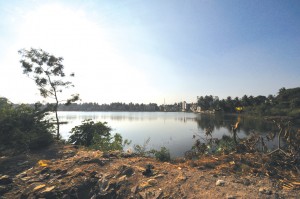 Madipakkam eri.
Madipakkam eri.
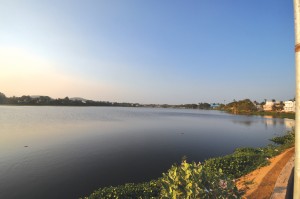 Chitlapakkam eri.
Chitlapakkam eri.
Chitlapakkam eri, which can be accessed from the Third Main Road, is a vital water body in the neighbourhood. It measures around 46 acres (down from 86 acres in the past). Like many other parts of Chennai, this was once an important agricultural area and the water from the lake (Pachamalai hill serves as a source for the lake) was used for irrigation. Back then, groundwater could be tapped at a depth of five to ten feet. The ready availability of water, growth in housing and lack of underground drainage in some areas around the lake have contributed to its degradation. Even so, grey herons and other migratory winged visitors, like pelicans, can be spotted here. The Chitlapakkam eri has a few social activists working for its protection. What is sad is that there is a humongous landfill bang next to it, a major source of concern. The activists are taking this up with the National Green Tribunal. A newspaper reading room in memory of former President of India A.P.J. Abdul Kalam and a convenient walkway make this lake a social hub.
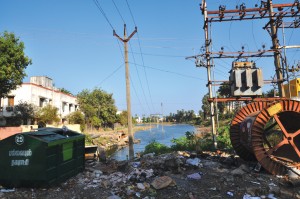 Kizhkattalai eri.
Kizhkattalai eri.Lakes come in all sizes. Looking at the Kizhkattalai lake, off Erikkarai Main Road, Rajendra Nagar, from the Perumal temple end might give you the impression that it is a small lake but when you get on to the main road and clamber up the slope you realise it has narrowed down in parts and only deceptively looks small.
While in Chromepet we found the South Madras Periya eri. One part of it is known as the Chitteri, south of Thiruneermalai. We caught a glimpse of this waterbody from the Thiruneermalai Main Road, Nagalkeni, a few kilometres short of the Thiruneermalai temple. Brimming with water, it is one of the larger lakes of Chennai .
I was reminded of the young man who took a selfie on a railway track when I got near the Vilinjambakkam Lake, for it can be viewed from the Madras-Tiruttani High Road close to the railway line. You have to crane your neck and peer over the track to catch a glimpse of the lake. It does not have much water at present.
Getting to Madhavaram past the Shoe House and all the Christian institutions (schools and hospitals started by missionaries) you come to Kamarajar Salai, MMDA 2nd Main, Mathur. The Madhavaram eri which can be seen from here is a fairly large eri fringed with palm trees and not too much of encroachment when compared to the Periathopu Lake which is further down the road. An overgrowth of weeds and a border at the far end, provided in keeping with current trends by vaastu-coloured buildings in blue, mauve, mango yellow, pista green etc, makes you want to turn away.
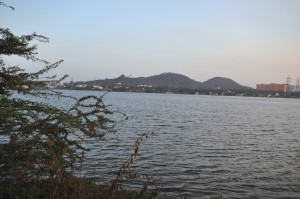 Thiruneermalai eri.
Thiruneermalai eri.
Other water bodies like the Vattaamani Kulam, also overgrown with weeds, and the water-logged banana plantations in Vichoor give you an idea of what Madhavaram and its neighbourhood must have been like. We wound our way along Manali and Ennore and finally reached the point where the Kosasthalaiyar River flows into the Ennore Creek and the Bay of Bengal.
I would never have forgiven myself if I had not visited the Sholavaram or Chozhavaram eri. The area is known also for an erstwhile race track which had been levelled from a World War II air strip. Beautiful, serene and vast, Sholavaram eri is one of the largest lakes in Chennai and would make for a perfect picnic spot (Why aren’t schoolchildren taken on such picnics any more?). Sholavaram eri (located on Bungalow Road in Ponneri Taluk, Tiruvallur District) is a rainfed reservoir from where water is drawn for supply to Chennai city via Puzhal Lake through canals. The reservoir dates to the 1800’s.
Ever since I started looking for the city’s lakes, I have becoming a changed person. The slightest hint of water sets me off and that is how I discovered the Satyanagar Lake in Villivakkam which an amused policeman (who queried “Eri peyar kekkurengala, illai en peyar kekkurengala?” Are you asking for the name of the eri or my name?) helped me put a name to. It is also in the Villivakkam area that we found the largish Thazhambakkam eri where work was going on – huge pipes et al. It was probably a sweet-smelling lake (hence the name), I mused.
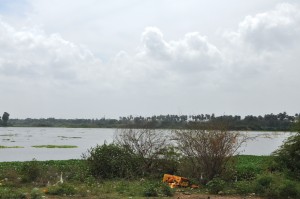 Madhavaram eri.
Madhavaram eri.
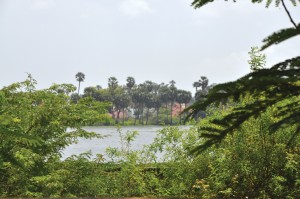 Vilinjambakkam Lake.
Vilinjambakkam Lake.
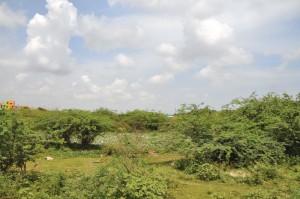 Periathopu Lake.
Periathopu Lake.
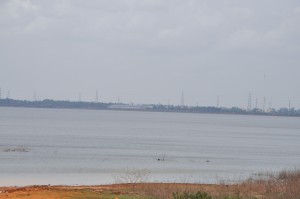 Sholavaram eri.
Sholavaram eri.
Again, as I was returning from Pune by air recently, I looked specifically for waterbodies as the plane began its descent into Chennai and, believe you me, I counted six. So the next time you are flying in to Chennai do take a window seat and track the lakes (Hopefully they won’t dry up too fast).
Lakes, I discovered, while working on this article can also be used to settle scores. As we were driving around in search of the Ayanambakkam tank I saw a steadily growing landfill with pigs, cows and even a little girl scrounging around in the muck. As we clicked a picture, ,a local joined us and filled us in on the story of two landowners who owned neighbouring plots with a waterbody in between. The game plan of the usurper was to annexe (“lock”) the neighbour’s plot by converting the waterbody into a landfill.
I set out wanting to cover every single lake in the city but as I got on I realised that was a tad too ambitious, given constraints of time, distance and space. So I had to content myself with the ones that I saw and even if each reader discovers one new lake through this series it would have been worth the effort. In my opinion, ours was a lake city once upon a time. Time we saved what’s left of it and treated it with the respect that it deserves.
(Concluded)
‘Gunduthva’ is not State Policy
When I saw actress Shabana Azmi and other celebrities who appeared on my television screen the other day to speak on Anti-Obesity Day, I thought it was also some kind of intolerance. Intolerance towards some people being obese. In my wild imagination, it sounded something like ‘Gunduthva’. ‘Become slim or else…!’
Let me, at the outset, clarify that ‘Gunduthva’ has nothing to do with Hinduthva; it is only a new word I coined for obesity. This is not against any religion, caste or creed. This is meant to help those who are obese and offer them advice not to carry so much weight throughout their lives.
“What if I am obese? How does it bother you?” may be questions large-sized people may ask. I am not prepared to engage in a fight with them. I care for my bones and do not indulge in unnecessary bones of contention.
There is serious concern about obesity all over the world. I know, however, obese people are not worried about this. Only those who are slim as a snake gourd worry about obese people.
I read somewhere, sometime ago, that an Indian doctor in the U.S., Dr. Ruchi Mathur in his research found out whether one would become obese or not. When both hydrogen and methane gas leave the body, it will indicate the fat content through the body mass index. The right place for generation of methane is the gastro-intestinal path. The micro mechanism in the digestive path converts the food into energy needed for the body, says Dr. Ruchi Mathur. When M. Smithil increases enormously, the level goes above the average and causes obesity, according to this Los Angeles based doctor. Like the alcohol test done by the traffic police at nights, the person has to blow into an instrument and the result is known instantly, whether he will become obese or not!
Obesity is bad for health, they say, particularly for the heart and the kidneys. Then why should one be obese?
The national family health survey done recently shows that Punjab is the first in the country in obesity. I thought Tamil Nadu would be second. No. It is hiding in fourth place in the list, which anyone, including this CBI, could easily find out. But a piece of consolation to Tamil Nadu is that only 20 per cent of them are obese; 25 per cent of Tamil Nadu women are obese.
Obesity clinics advise men and women belonging to the ‘Gunduthva’ brigade what they should observe or do. One woman, who was originally 90 kilos, lost 35 kilos through bariatric surgery!
Everybody knows how the singer Adnan Sami looked a couple of years ago. Now he looks slim and handsome. Because of this, he gets the advantage of free publicity, whether he performs or not. How lucky!
It is common in any city – be it Chennai, Coimbatore or Madurai – for women to lose weight. Yes, the weight of the chain they wear. Either in the morning while drawing kolam in front of the house or in the evening while returning from office or shopping. When the chain snatcher takes away only the gold, he does not take away the extra pound of flesh in the neck region. If the loser chases the snatcher for about two kilometers or more, she may lose some weight. But running one day alone will not help. It is not advisable to wear a new chain every day and lose it the same day to prove chasing helps reduce body weight. It is not economically viable and is certainly a costly proposition.
A new gym has been opened in our locality. It has advertised that there will be 25 per cent and 50 percent discount for those who join the gym. It was not clear whether if the person loses 25 percent weight, he would be given 25 percent discount.
There is a story. Once, a slim man looking at an obese man said, “People will think the reason for famine in this country is because of people like you.” We do not know whether the slim man got a reply or a kick.
They say it is hereditary to be obese. Grandfather, father and son. In Hindi films of the 1950s and 60s, there was one Tun Tun, a huge woman who was a comedienne. Viewers would laugh at the very sight of the actress.
I do not know whether being obese is good or bad from the health point of view. But in one way, it helps. Let me narrate an incident I witnessed.
A slim man was walking in the morning with his ‘Minor’ chain glittering between his neck and the shirt collar. A tempted cyclist rider went past him and snatched at his gold chain. The slim man shouted and caught him. The cyclewallah did not know that the slim man’s wife belonging to the ‘gunduthva’ brigade was just behind him. In a fleeting moment, she caught hold of him and began beating him black and blue. The fortunate or unfortunate husband started shouting, “Leave him, poor man. The chain is safe on my neck. Let go of the poor fellow!” The first-time offender collected his cycle and ran. I do not know whether the poor husband received the rest of the blows after reaching home for being careless.
There are, therefore, advantages in having an obese wife in instances like this. Bridegrooms in search of suitable girls should not, therefore, reject obese girls outright. They may become saviours when men are in danger.
Election year is fast approaching. Whatever the voters demand, they will get from the government. People belonging to Gunduthva – I mean people who are obese – can form an association, a kind of vote bank, and demand several concessions like free bariatric surgeries, double the quantity of ration articles, etc. The rulers will definitely grant these boons.
-Charukesi

